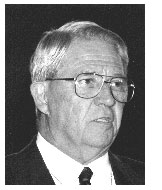Volume 5, Number 4—August 1999
Conference Summary
About the First National Symposium on Medical and Public Health Response to Bioterrorism
On February 16-17, 1999, in Arlington, Virginia, 950 public health officials, physicians, and other medical personnel, along with government, military, and intelligence experts gathered for the first National Symposium on Medical and Public Health Response to Bioterrorism. Participants were geographically diverse. Represented were 46 states, plus Washington, D.C., and 10 countries: Australia, Austria, Canada, England, Finland, France, Germany, Israel, Italy, and the Netherlands.
The guiding force behind the symposium was the newly established Johns Hopkins Center for Civilian Biodefense Studies, which hopes the discussions will lead to a framework and partnership for strategic planning. The other main sponsors were the Department of Health and Human Services, Infectious Diseases Society of America, and American Society for Microbiology. Twelve other public health professional societies supported the conference.1
The list of speakers included D.A. Henderson, director of the Johns Hopkins Center for Civilian Biodefense Studies; Christopher J. Davis, former senior intelligence analyst for chemical and biological warfare matters on Britain's Defense Intelligence staff; Jessica Stern, Council on Foreign Relations and author of the book The Ultimate Terrorists; Joshua Lederberg, Nobel laureate and professor and president emeritus of Rockefeller University; Col. Gerald W. Parker, director of the U.S. Army Medical Research Institute of Infectious Diseases; Thomas V. Inglesby and Tara O'Toole, Johns Hopkins Center for Civilian Biodefense Studies; and Philip K. Russell, Johns Hopkins School of Public Health.
Federal, state, and local officials reflected on the challenge of coordinating a multidisciplinary and interagency response to a biological attack. This array of speakers included Secretary of Health and Human Services Donna Shalala; Richard Clarke, National Security Council; Michael Osterholm, Minnesota Department of Health; and Jerry Hauer, director of New York City's Office of Emergency Management.
From their different backgrounds and perspectives, the more than 20 speakers addressed the following questions: Why are current concerns about bioterrorism real? Why must the medical and public health communities address the issue of bioterrorism? Which biological threats warrant the most concern? What is the possible aftermath of an act of biological terrorism?
A warning against complacency came from the symposium's closing speaker, Margaret A. Hamburg, assistant secretary for planning and evaluation, U.S. Department of Health and Human Services.
In making symposium presentations available here, the organizers hope to raise awareness of the medical and public health threats posed by biological weapons and to foster mutual understanding and collaboration among the diverse groups addressing the threat of bioterrorism.
1American College of Preventive Medicine, Association for Professionals in Infection Control and Epidemiology, Association of Public Health Laboratories, Association of Schools of Public Health, Association of State and Territorial Health Officials, Commissioned Officers Association of the U.S. Public Health Service, Council of State and Territorial Epidemiologists, National Association of County and City Health Officials, National Association of Local Boards of Health, Partnership for Prevention, Public Health Foundation, and Society of Hospital Epidemiologists of America.
Table of Contents – Volume 5, Number 4—August 1999
| EID Search Options |
|---|
|
|
|
|
|
|
